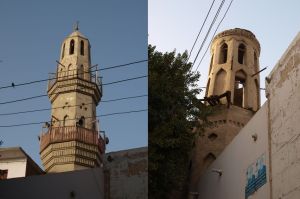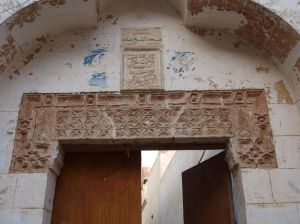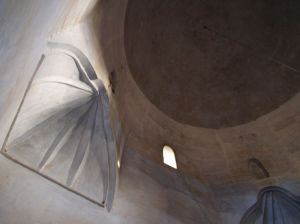Visit to the Sheikh Ebada mosque and the tomb of Ebada Ibn Samet
Once again finding time to be able to write is getting difficult, with the survey work going on at a strong pace. Time for two blogs this evening, later on some updates on the survey, but for now a description of a short trip the team made the other evening to the mosque in Sheikh Ebada, and to the tomb of Ebada Ibn Samet. The mosuqe is located in t he northern part of Sheikh Ebada, aligned with the northern decumanus of the Roman city. It therefore seemed appropriate to visit and to see if anything associated with the Roman and later archaeology of the area was present in the fabric of the building.

The two minarets of the Sheikh Ebada mosque (left) the later minaret and (right) and earlier minaret, supposedly the tower of an earlier church
The mosque has two minarets, one in use, and the other of mud-brick supposedly associated with an earlier church on the site. Although this may be doubtful, a number of interesting architectural fragments do remain. A carved lintel above the door to the mosque courtyard, according to the locals of Fatimid date, makes for a decorative feature on the west facing entrance to the compound, and is matched by a similar, albeit whitewashed, block above the small door to the prayer hall.
In the bathing area two reused columns are visible, both painted. The first is a straight uncarved column, but the second has spiral fluting, and is damaged on its upper section, exposing what appears to be quartzite stone. Both have bases and capitals and suggest reuse of Roman columns from the site.
Four further columns are visible in the prayer hall, supporting the arches of the hall, with capitals, again all appearing to be reused from Roman buildings. All of these columns have painted decoration so it was not possible to assess the stone types.
The tomb area of the mosque is domed, with supports in each corner visible as moulded plaster. All in all a beautiful building, with architectural fragments from different phases of its history. No solid evidence of pre-Islamic foundation, even though its location may suggest underlying Roman structures.
It needs to be stated that the mosque with the tomb of Ebada Ibn Samet is one of two at Sheikh Ebada. We may be able to check out the second one located to the south at some point in the next few days.




